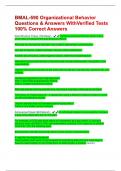BMAL-590 Organizational Behavior
Questions & Answers WithVerified Tests
100% Correct Answers
Dual Structure Theory (Herzberg) - ✔️✔️Herzberg proposed the two-factor theory
which later on became the dual structure theory.
Although not favored by scholars, the model is appealing to practitioners.
One set of factors, called motivation factors, affect satisfaction.
Another set of factors, called hygiene factors, determine dissatisfaction.
Motivation factors are intrinsic to the work and include achievement, recognition, and
responsibility.
Hygiene factors are extrinsic to the work and include pay, job security, personal life, and
policies.
Herzberg suggested a two-step approach:
Step 1: Eliminate dissatisfaction factors.
Step 2: Create motivational factors.
Although popular among practitioners, the theory has been criticized by scholars.
The theory is "method bound" - a researcher using a different method is likely to come
up with contradictory results.
Original sample does not represent general population.
Factors vary widely across cultures.
Achievement Need (McClelland) - ✔️✔️an individual's desire to accomplishor achieve
a goal more effectively than in the past.
For example, a CEO may track return on investment as a key metric. If, during a
particular year, the ROI is 15%, an achievement-oriented CEO might try to achieve
more than 15% the following year.
Achievement oriented individuals tend to have certain characteristics:
A need for immediate feedback.
Preoccupation with work to the exclusion of everything else (16-hour work days?).
Assume responsibility to get things done (a sales target, a product launch).
,Affiliation need - ✔️✔️the need for human companionship.
Individuals with a high affiliation need:
Expect approval and reassurance from colleagues and supervisors.
Tend to be sensitive to others' feelings.
Follow the golden rule (treat others as they would like to be treated).
Individuals with a low affiliation need:
Work best when left alone.
Find it difficult to be courteous and friendly all the time.
Power - ✔️✔️the desire to control the environment and resources - financial, material,
information, and people.
Some people actively seek power. Others avoid it.
Prerequisites for those with a high power need to be successful managers:
Seek power to enhance organizational performance, not to extend personal influence.
Have a low affiliation need.
Equity theory (Adams) - ✔️✔️the relatively simple concept that people in organizations
want to be treated fairly.
Equity
- the belief that we are being treated fairly in relation to others.
Inequity
- the belief that we are being treated unfairly in relation to others
An Interdisciplinary Domain - ✔️✔️It should be obvious from the preceding outline that
OB is not a monolithic domain or discipline of study.
OB draws from many disciplines to understand and explain individual and group
behavior.
OB draws from psychology while explaining why we behave the way we do.
OB draws from anthropology while understanding the evolution of behavior over time.
OB draws from sociology while exploring how households, families, and society interact
and lead to discernable patterns of behavior and tradition.
,OB draws from engineering while examining measurement techniquesand productivity.
OB draws from statistics to understand trends and relationshipsbetween variables.
OB draws from medicine to recognize the importance of wellness and health.
Organization as a System - ✔️✔️It is useful to view an organization as a system.
A system is a set of interrelated parts that work together towards a well-defined
objective.
Most systems have a control mechanism to correct and prevent deviation from the
desired level in system performance.
Control can be at the input, process, or output stage.
The output is one or more products, some waste, and information.
Feedback can be about quality, efficiency, or productivity.
Control would be steps to minimize deviations.
A system has some distinct characteristics: - ✔️✔️One or more inputs
One or more processes that transform the inputs
One or more outputs
A feedback loop to measure efficiency and effectiveness
Inputs to an organizational system (manufacturing)include: - ✔️✔️Capital
People
Raw materials
Information
Technology
The processes may involve: - ✔️✔️Physical
Chemical
Mechanical
Electronic
Assembly Lines
Test facilities
Systems and Subsystems - ✔️✔️A typical system has many subsystems.
, An organizational system, for example, has marketing, finance, manufacturing, service,
human resources, and technology subsystems.
Similarly, the organization itself is a part of a larger system that includes the political,
economic, social, and technological systems. (PEST)
Organization as a System - Baldrige Model - ✔️✔️One of the widely used frameworks
or models for understanding and improving organizational systems is the Baldrige
Excellence Model.
Baldrige model has several subsystems: - ✔️✔️Leadership
- the first subsystem, provides the mission, vision, objectives, and core values of the
organization.
* Mission- What is our business?
* Vision- What do we aspire to become?
* Objectives- How do we measure?
* Core Values- What do we believe in and stand for?
Strategy
- How do we succeed? By lowering costs? By offering something unique? By
operational excellence? By understanding and serving our customers? By combining all
of the above?
Customers
- Who are our customers? Where are they located?What are they looking for? What is
the "job to be done"? How do we offer what our customers want?Internal and External
customers.
Workforce
- the most important resource of an organization are its people. How to hire, orient,
train, motivate, compensate, develop, and retain a talented workforce?
Operations
- How do we transform inputs into outputs better than competitors? How do we maintain
world-class quality? How do we provide exceptional service?
Results
- How do weMeasure success?Profits?Shareholder value? Market share? Customer
satisfaction Reputation? Brand recognition?
Results
- How do we Measure success? Profits? Shareholder value? Market share? Customer
satisfaction?Reputation? Brand recognition?
Core Values




